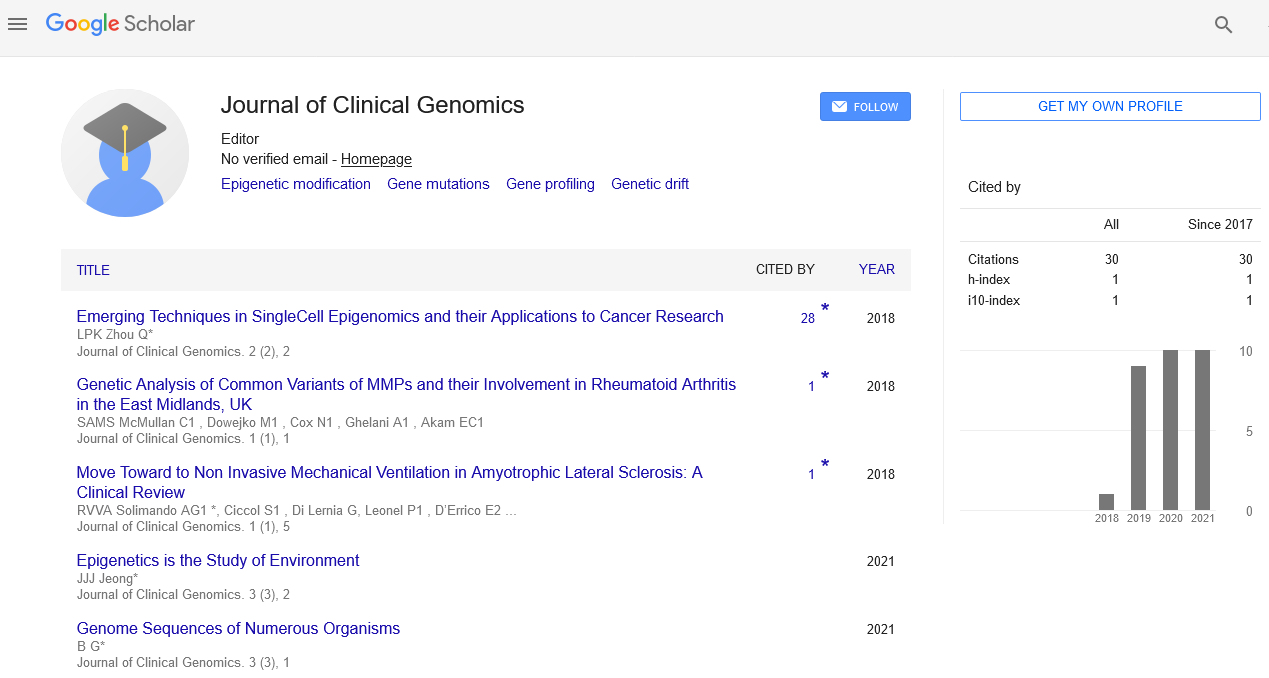Perspective, J Clin Genom Vol: 5 Issue: 1
Recognizing Gene Profiling Methods to Decipher Genomics
Quan Yasbanoo*
1Department of Applied Chemistry, University of Science & Technology of China, Hefei, China
*Corresponding Author: Quan Yasbanoo
Department of Applied Chemistry,
University of Science & Technology of China, Hefei, China
E-mail: quanyasba@ustc.edu.cn
Received date: 03 February, 2023, Manuscript No. JCG-23-96323;
Editor assigned date: 07 February, 2023, PreQC No. JCG-23-96323 (PQ);
Reviewed date: 21 February, 2023, QC No. JCG-23-96323;
Revised date: 28 February, 2023, Manuscript No. JCG-23-96323 (R);
Published date: 07 March, 2023, DOI: 10.4172/JCG.1000120
Citation: Yasbanoo Q (2023) Recognizing Gene Profiling Methods to Decipher Genomics. J Clin Genom 5:1.
Description
Gene profiling methods are essential tools in genomics research that allow scientists to study gene expression levels, alternative splicing events, and gene regulation. These methods provide valuable insights into the functional roles of genes and their involvement in various biological processes, diseases, and drug responses.
Microarray-Based Gene Profiling
Microarray-based gene profiling is a widely used high-throughput method for measuring gene expression levels using DNA probes on glass slides or chips that hybridize with complementary Ribonucleic Acid (RNA) molecules, detected by fluorescence signals from labeled, copy Deoxyribonucleic Acid (cDNA) or RNA samples.
Advantages of microarray-based gene profiling
Microarray-based gene profiling has several advantages, including:
High throughput: Microarrays can measure the expression levels of thousands of genes simultaneously, allowing for efficient screening of large gene sets in a single experiment.
Cost-effective: Microarrays are relatively affordable compared to other gene profiling methods, making them accessible to many researchers.
Established technology: Microarrays have been widely used for gene expression analysis for many years, and there are wellestablished protocols and analysis tools available.
Long-term data availability: Microarray data from previous studies are often publicly available, allowing for comparison and integration of results from different studies.
Limitations of microarray-based gene profiling
Despite their widespread use, microarray-based gene profiling methods have some limitations, including:
Dependency on annotated gene sequences: Microarrays rely on predefined probes designed based on known gene sequences. If the reference genome or transcriptome is incomplete or inaccurate, it can impact the accuracy and interpretation of the gene expression data.
Limited detection of novel transcripts: Microarrays may not accurately capture novel transcripts or alternative splicing events, as they are based on known gene sequences.
Dynamic range of gene expression detection: Microarrays may not accurately capture the full range of gene expression levels, especially for low-abundance transcripts, leading to potential false negatives or underestimation of gene expression.
Batch effects: Technical variations between different microarray experiments can introduce bias and affect the reproducibility and comparability of the results.
RNA-Seq-Based Gene Profiling Methods
RNA sequencing (RNA-seq) has emerged as a powerful alternative to microarray-based gene profiling methods. RNA-seq involves the direct sequencing of cDNA molecules, providing a digital readout of gene expression levels.
Advantages of RNA-seq-based gene profiling
RNA-seq-based gene profiling has several advantages, including:
Unbiased detection of gene expression: RNA-seq does not rely on predefined probes like microarrays, allowing for unbiased detection of gene expression levels, including novel transcripts, alternative splicing events, and non-coding RNAs.
Higher dynamic range: RNA-seq has a higher dynamic range compared to microarrays, allowing for more accurate detection of lowabundance transcripts and quantification of gene expression levels across a wide range.
Digital quantification: RNA-seq provides a digital readout of gene expression levels, allowing for precise and quantitative measurement of gene expression.
Higher resolution: RNA-seq can provide higher resolution in detecting differential gene expression, allowing for more precise identification of genes that are differentially expressed in different conditions or disease states.
Flexibility and versatility: RNA-seq can be used for various applications beyond gene expression analysis, such as identification of alternative splicing events, detection of fusion genes, and profiling of non-coding RNAs, providing more versatility in genomics research.
Limitations of RNA-seq-based gene profiling
RNA-seq-based gene profiling methods also have some limitations, including:
Higher cost: RNA-seq can be more expensive compared to microarrays, particularly for large-scale studies or when sequencing depth and coverage need to be increased.
Data analysis complexity: RNA-seq data analysis requires specialized bioinformatics skills and computational resources for read alignment, quantification, and downstream analysis, which can be more complex compared to microarrays.
Sensitivity to sequencing biases: RNA-seq data can be sensitive to various sequencing biases, such as Guanine-Cytosine (GC) content, sequencing depth, and library preparation methods, which can affect the accuracy and interpretation of the results.
Rapidly evolving technology: RNA-seq technology is continuously evolving, with new platforms, protocols, and analysis tools being developed, which may require researchers to constantly update their skills and knowledge.
Conclusion
Gene profiling methods, such as microarray-based gene profiling and RNA-seq-based gene profiling, are powerful tools in genomics research for deciphering gene expression patterns, alternative splicing events, and gene regulation, with each method offering distinct advantages and limitations.
 Spanish
Spanish  Chinese
Chinese  Russian
Russian  German
German  French
French  Japanese
Japanese  Portuguese
Portuguese  Hindi
Hindi 